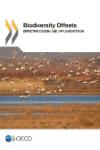Biodiversity, water and natural resource management
Policy instruments for biodiversity
 |
A number of policy instruments are available for the conservation and sustainable use of biodiversity. The OECD’s work examines a range of existing and emerging policy instruments, drawing on insights from literature and country case studies. |
|
OECD submission on Target 18 on Incentives of the post-2020 Global Biodiversity Framework The OECD Secretariat provided the above submission to the CBD Secretariat, on 17 March 2022, on proposed Target 18 of the Post-2020 Global Biodiversity Framework. |
|
|
Tracking Economic Instruments and Finance for Biodiversity 2021 This 2021 brochure highlights the latest data on biodiversity-relevant economic instruments (known as positive incentives under the CBD Post-2020 Global Biodiversity Framework) and the finance they mobilise, across more than 120 countries. It covers biodiversity-relevant taxes, fees & charges, tradable permits, environmentally-motivated subsidies, PES & biodiversity offsets – key instruments to mainstream biodiversity across sectors and incentivise more sustainable behaviour. |
|
|
This report provides an overview of methodologies to evaluate the effectiveness of policy instruments for biodiversity, covering impact evaluation, cost-effectiveness analysis and other more commonly used approaches. It then provides an inventory of biodiversity-relevant impact evaluation studies, across both terrestrial and marine ecosystems. The report concludes with lessons learned, policy insights and suggestions for further work. |
 |
|
Sustainable financing for marine ecosystem services in Mauritania and Guinea-Bissau, 2018 This paper examine the efforts of Mauritania and Guinea-Bissau to establishing sustaianble financing for marine protected areas, via conservation trust funds, to help conserve and sustainable use these vita ecosystems. This country study draws on the 2017 OECD report The Political Economy of Biodiversity Policy Reform. |
 |
|
Sustaining Iceland’s fisheries through tradeable quotas - Country Study, 2017 This paper analyses the reform undertaken by Iceland to avert a looming crisis and restore fish stocks to sustainable levels. The paper outlines the process involved in designing and implementing this reform. It also reflects on the challenges encountered and the environmental, economic and social impacts of the reform. It concludes by discussing some wider lessons learned for other governments seeking to tackle similar environmental problems. This country study draws on the 2017 OECD report The Political Economy of Biodiversity Policy Reform. |
 |
|
Reforming agricultural subsidies to support biodiversity in Switzerland - Country Study, 2017 This paper analyses the reform of Switzerland’s agricultural policy framework, which reoriented subsidies to better target policy objectives, including for biodiversity. The paper outline the process involved in designing and implementing the reform as well as its environmental and socio-economic impacts. It also highlights the challenges encountered and concludes by discussing the wider lessons for other governments seeking to tackle similar challenges. The country study draws on the 2017 OECD report The Political Economy of Biodiversity Policy Reform. |
 |
|
Marine Protected Areas: Economics, Management and Effective Policy Mixes, 2017 Intense exploitation of our oceans and seas is degrading marine biodiversity and ecosystems at an alarming rate. This report presents good practice insights for effectively managing marine protected areas (MPAs), one of the policy instruments available for the conservation and sustainable use of marine biodiversity and ecosystems. It covers costs and benefits of MPA's, effective design, scaling up finance for MPAs, and how to embed them into policy mixes. |
|
|
Biodiversity Offsets: Effective Design and Implementation, 2016 This book examines the opportunities and challenges associated with biodiversity offset programmes and provides policy makers and practitioners with good practice insights on their design and implementation so as to ensure more effective outcomes. It draws on lessons and insights from more than 40 case studies worldwide and three in-depth reviews from the United States, Germany and Mexico. |
 |
|
Scaling up Finance Mechanisms for Biodiversity, 2013 This report examines six mechanisms that can be used to scale-up financing for biodiversity conservation and sustainable use and to help meet the 2011-20 Aichi Biodiversity Targets. The mechanisms are environmental fiscal reform, payments for ecosystem services, biodiversity offsets, green markets, biodiversity in climate change funding, and biodiversity in international development finance. Drawing on literature and more than 40 case studies worldwide, this book addresses the following questions: What are these mechanisms and how do they work? How much finance have they mobilised and what potential is there to scale this up? And what are the key design and implementation issues that need to be addressed so that governments can ensure these mechanisms are environmentally effective, economically efficient and distributionally equitable? |
|
|
Paying for Biodiversity: Enhancing the Cost-Effectiveness of Payments for Ecosystem Services, 2010 This book identifies good practice in the design and implementation of PES programmes to enhance their environmental and cost effectiveness. It addresses the following questions: Why are PES useful and how do they work? How can they be made most effective environmentally and how can their cost-effectiveness be maximised? What are the different potential sources of finance for PES programmes, and how can they be secured? What are the lessons learned from existing PES programmes and insights for future programmes, including international PES? |
|
|
People and Biodiversity Policies: Impacts, Issues and Strategies for Policy Action, 2008 Biodiversity policies promote the protection, conservation, and sustainable use of biologically diverse ecosystems and habitats. In doing so, they create significant public benefits and contribute to social well-being. However, the implementation of biodiversity policies will often benefit different groups to a greater or lesser degree. At times, some groups in society lose out under certain policies. For example, in establishing a property right to facilitate management of a biodiversity-related resource, people who previously had unrestricted use will be adversely affected. |
|
|
Handbook of Market Creation for Biodiversity: Issues and Implementation, 2004 This book shows how public policy in the form of market creation can be used to internalise the loss of biodiversity. It promotes the use of markets to ensure that our collective preferences for conversation and sustainable use are reflected in economic outcomes. Striking the right balance between the conservation/sustainable use and the loss of biodiversity requires accounting for all the impacts of its destruction. Weighing the loss against any potential benefits will ensure that the social, as well as economic, well-being of everyone are at the best levels possible. Market-based economic systems have the potential to ensure that such a balancing occurs, but require that all the impacts of its loss, or use, have been fully internalised into market transactions. |
|
|
Harnessing Markets for Biodiversity: Towards Conservation and Sustainable Use, 2003 The private provision of biodiversity products and services is proving to be quite feasible in some circumstances. Some biodiversity products and services are already being profitably marketed. Private markets also need to be supported by appropriate public policies. This publication provides a conceptual framework for market creation in the biodiversity policy arena, as well as several examples of where the use of markets can assist policy makers in the search for more sustainable use and conservation of biodiversity. |
|
|
Handbook of Incentive Measures for Biodiversity: Design and Implementation, 1999 This Handbook draws on the experiences described in 22 case studies to develop a comprehensive step-by-step process for identifying and implementing appropriate incentive measures for biodiversity conservation, and the sustainable use of its components. It identifies the incentive measures that are most suitable for particular ecosystems, and for addressing the specific sectoral pressures in effect, describing both the advantages and the disadvantages of each incentive measure. A wide range of incentive measures are described, including both the more common economic and regulatory incentives, and also the necessary framework conditions, such as scientific and technical capacity building, education and awareness raising, and the involvement of local populations and other stakeholders. |
|
|
Saving Biological Diversity: Economic Incentives, 1996 The earth's biological diversity, or "biodiversity" in its widest sense is synonymous with "life on earth." Its loss has become an international concern in recent years and has led to the rapid ratification of the Convention on Biological Diversity, one of three international environmental treaties signed at the United Nations "Earth Summit" at Rio de Janeiro in 1992. But what are the most effective policy measures and strategies to safeguard it? Incentive measures have been identified by the Convention on Biological Diversity as an option, and pursued in many OECD countries. This report, with contributions from many recognised experts in the field, examines the status of biodiversity in OECD countries, the underlying pressures on it, and the role of incentive measures to help guide policy and human action towards conserving and sustainably using biodiversity. |
|
FURTHER READING
- OECD Environment Working Papers on biodiversity
- OECD Environment Working Papers and Environment Policy Papers
- Biodiversity, water and natural resource management
Related Documents







